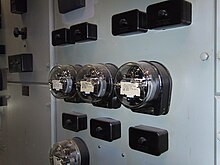ANSI numbers for
electrical circuit:
|
2
|
Time delay switching (or) closing
|
|
3
|
Checking (or) interlocking
|
|
7
|
Rate of change
|
|
21
|
Distance relay
|
|
24
|
Volt per hertz relay
|
|
27
|
Under voltage
|
|
30
|
Annunciation relay
|
|
32
|
Directional power relay
|
|
37
|
Under current (or) under power relay
|
|
40
|
Field over/under excitation relay
|
|
44
|
Unit sequence starting relay
|
|
46
|
Reverse phase (or) phase balance current relay
|
|
47
|
Phase sequence or phase balance voltage relay
|
|
48
|
Incomplete sequence relay
|
|
49
|
Mechanical or trans thermal relay
|
|
50
|
Instantaneous over current relay
|
|
51
|
Ac inverse time
over current relay
|
|
53
|
Exciter or dc gen relay
|
|
55
|
Power factor relay
|
|
56
|
Field app relay
|
|
58
|
Rectification failure relay
|
|
59
|
Over voltage relay
|
|
60
|
Voltage or current unbalance relay
|
|
62
|
Time delay stopping or opening relay
|
|
64
|
Ground detector relay
|
|
67
|
AC direction over current relay
|
|
68
|
Blocking or out of step relay
|
|
74
|
Alarm relay
|
|
76
|
DC over current relay
|
|
78
|
Phase angle measuring relay
|
|
79
|
AC reclosing relay
|
|
81
|
Frequency relay
|
|
82
|
DC reclosing relay
|
|
83
|
Automatic selective control or transfer relay
|
|
85
|
Communication or pilot wire relay
|
|
86
|
Lockout relay (Master trip relay)
|
|
87
|
Differential protection relay
|
|
87L
|
Line differential relay
|
|
87T
|
Transformer differential relay
|
|
87G
|
Generator differential relay
|
|
91
|
Voltage direction relay
|
|
92
|
Volt & power direction relay
|
|
94
|
Tripping & trip frequency relay
|
|
1
|
Master element
|
|
2
|
Time delay starting or closing relay
|
|
3
|
Checking or interlocking relay
|
|
4
|
Master contactor
|
|
5
|
Stopping contactor
|
|
6
|
Starting circuit breaker
|
|
7
|
Rate of change relay
|
|
8
|
Control power distribution device
|
|
9
|
Reversing device
|
|
10
|
Unit sequence switch
|
|
11
|
Multifunction device
|
|
12
|
Over speed device
|
|
13
|
Sync-speed device
|
|
14
|
Under speed device
|
|
15
|
Speed or frequency matching device
|
|
16
|
Data communication device
|
|
17
|
Shunting or discharge switch
|
|
18
|
Accelerating or de-accelerating device
|
|
19
|
Starting to running
|
|
20
|
Electrically operated valve
|
|
29
|
Isolating contactor or switch
|
|
22
|
Equalizer circuit breaker
|
|
23
|
Temperature control device
|
|
25
|
Synchronizing check device
|
|
26
|
Apparatus thermal device
|
|
28
|
Flame detector
|
|
31
|
Separate excitation device
|
|
33
|
Position switch
|
|
34
|
Master sequence device
|
|
35
|
Brush operating or slip ring –sc device
|
|
36
|
Polarity or polarizing voltage device
|
|
38
|
Bearing protective device
|
|
39
|
Mechanical condition monitor
|
|
41
|
Field circuit breaker
|
|
42
|
Running circuit breaker
|
|
43
|
Manual transfer or selector device
|
|
45
|
Abnormal atmospheric condition monitor
|
|
52
|
AC circuit breaker
|
|
54
|
Turning gear engaging device
|
|
57
|
Short circuit or grounding device
|
|
61
|
Density switch or sensor
|
|
63
|
Pressure switch
|
|
65
|
Governor
|
|
66
|
Notching or jogging device
|
|
69
|
Permissive control device
|
|
70
|
Rheostat
|
|
71
|
Liquid level switch
|
|
72
|
DC circuit breaker
|
|
73
|
Load resistor contactor
|
|
75
|
Position changing mechanism
|
|
77
|
Telemetering device
|
|
80
|
Flow switch
|
|
84
|
Operating mechanism
|
|
89
|
Line switch
|
|
93
|
Field changing contactor
|
|
90
|
Regulating device
|
|
88
|
Auxiliary motor or motor generator
|





